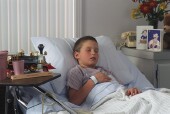Spray Cuts Kids' Pain When Getting IVs
But it may not be much more effective than placebo, one expert says.
By Steven Reinberg
HealthDay Reporter
|
E-mail this article
Subscribe to news
Printer friendly version
|

(SOURCES: William Splinter, M.D., staff anesthesiologist, medical director, palliative care, Children's Hospital of Eastern Ontario, Ottawa, Canada; Mark Greenberg, M.D., associate clinical professor, pediatrics and anesthesiology, and director, pediatric anesthesia, University of California, San Diego; July 1, 2008, Canadian Medical Association Journal
)
MONDAY, June 30 (HealthDay News) -- A topical spray reduces the pain of placing intravenous (IV) lines in children, Canadian researchers report.
The spray, called Pain Ease, reduced pain by 34 percent in children getting IV lines when compared with a placebo group and improved the success rate of inserting the lines, said lead researcher Dr. William Splinter, a staff anesthesiologist and medical director of palliative care at Children's Hospital of Eastern Ontario in Ottawa.
"This feature is especially important when time is limited, such as in a busy office practice or emergency department, where topical methods of pain relief have not traditionally been available," Splinter said.
These results are significant as previous studies of similar vapocoolant sprays did not show a reduction in pain during IV line insertion in children, Splinter added.
The report is published in the July 1 issue of the Canadian Medical Association Journal.
In the study, Splinter's team randomly assigned 80 children, aged 6 to 12, undergoing urgent intravenous procedures, to the spray or placebo. The effectiveness of the spray was based on the children's own report of pain and an assessment by their parents and the nurses of how easily the procedure went.
In addition to reducing pain, inserting the needle or tube was more successful among patients treated with the spray, the researchers found.
"Effective pain relief combined with improved success on first cannulation [insertion] attempt results in fewer repeat attempts, decreased procedure times, and improved satisfaction among children, parents and health-care providers," Splinter said.
The spray is nontoxic, less expensive than alternatives, works immediately, and does not require a needle, Splinter noted.
Dr. Mark Greenberg, director of pediatric anesthesia at the University of California, San Diego, said the study leaves many questions unanswered.
"Although there was some decrease in pain from the spray, there were some patients who had minimal pain with the placebo spray, suggesting just spraying anything on there might decrease pain," Greenberg said.
More important, the average age of the patients was probably a big factor in the findings, Greenberg said.
"If there were younger patients, I doubt the results would be the same. Nine-year-olds are probably the easiest patients' veins to cannulate. They are also fairly cooperative. If you had a mean age more like 3 to 4 years, with a significant amount of younger patients, you would probably see very little difference between the actual spray and placebo," Greenberg said.
In addition, the discomfort with the application of the coolant is not reported and would likely be a significant negative issue in younger children, Greenberg said.
"I think analgesia for IV starts in both children and adults is long overdue. I just don't think this study conclusively showed that using vapocoolants accomplishes this," Greenberg said.
More information
For more on hospital treatments and children, visit the American Academy of Pediatrics. 
Copyright © 2008 ScoutNews, LLC. All rights reserved. 
HealthDayNews articles are derived from various sources and do not reflect federal policy. healthfinder.gov does not endorse opinions, products, or services that may appear in news stories. For more information on health topics in the news, visit the healthfinder.gov health library.